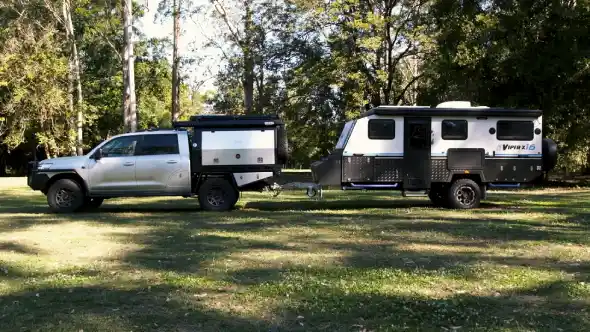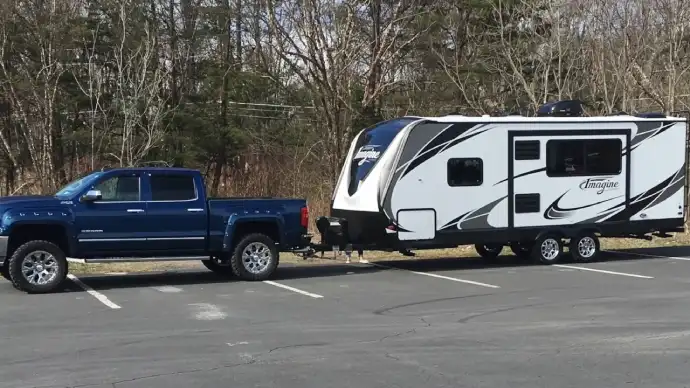Last Updated on May 7, 2023
Taking a road trip can be fun and exciting, but your vehicle must be up for the challenge to ensure you get there safe and sound. If you own a truck, consider adding some serious power with an additional 3-inch lift kit, this will give your ride more of an edge on the highway. But how exactly does it affect towing?
Well, the truth is that it really depends on what kind of lift kit you get. Body lifts won’t change the towing capacity, but suspension lifts will definitely have an effect. To guarantee that everything runs smoothly on your off-road excursions, consider modifications carefully before hitting the open road.
Bigger isn’t always better when it comes to towing. Let’s discuss why this is and what precautions you should take before hitting the road.
When Will a 3 Inch Lift Kit Affect My Towing: 5 Factors

Installing a 3-inch body lift kit on your vehicle will not diminish its towing capacity, as it only raises the frame with no effect on any suspension components. On the other hand, adding a 3-inch suspension lift can bring about noticeable changes in terms of what you’re able to tow.
Here are some reasons why your towing capability might be affected:
Altered Center of Gravity
When you install 3-inch suspension lift kits to your vehicle, you increase the distance between the ground and its center of gravity. This can have some dramatic effects on the way that it handles when towing a load.
The increased center of gravity makes it more susceptible to tipping over when cornering due to its increased rollover risk. While carrying a load, you may feel less grip from the road surface when accelerating or braking than if you weren’t.
Reduced Payload Capacity
The reduced payload capacity is one of the most apparent effects of installing a 3-inch suspension lift kit onto your vehicle. At the same time, exact specifications vary depending on individual vehicles and components used in their build.
Generally speaking, most vehicles cannot carry as much weight once modified with a lift kit due to increased strain placed on their springs and other mechanical parts. Any heavy hauling activity with an altered vehicle should consider the reduction in payload capacity.
Altered Suspension Geometry
By upgrading your suspension with a three-inch lift kit, you’re also altering the geometry of your suspension system by changing the ride height compared to what it was designed for. Increasing ride height decreases wheel travel, so it’s less comfortable for passengers off-road or over rough terrain.
Aside from this, the decrease in wheel travel reduces traction available from each wheel, partly due to shorter contact patches. But also because shocks now become stiffer, resulting in less impact absorption.
As a result, on- and off-road activities like pulling trailers or caravans further lose traction.
Changes in Axle Ratio
The axle ratio gets affected by a 3-inch suspension lift kit because it changes not only the center of gravity but also gear ratios in differentials. It determines how much torque is available at each wheel compared to the stock settings provided by the manufacturers before modifications have been made.
Generally speaking, increasing ride height decreases gearing ratios since power is transferred more slowly between drive shafts. This requires more energy, thus reducing overall efficiency throughout transmission systems and reducing torque available at each wheel.
Pulling heavier items may be harder now based on stock settings and prior modifications made via the lift kits installation. It’s especially true for long hauls where engines need time to warm up while they get used to higher RPMs required to move heavy loads efficiently.
Reduced Stability
Reducing stability is mostly due to an increased center of gravity, which we’ve already discussed in terms of how it affects cornering. However, as mentioned in the previous subsection, reducing stability has additional implications, like pushing limits on normal operating envelopes.
Since lifting increases the chances of veering off track, especially under heavy loads coupled with decreased traction characteristics discussed in previous subheaders. It means you can’t do a few dynamic maneuvers without being careful.
Otherwise, risk damaging yourself, past passengers, and future liabilities alike.
Can a 3″ Lift Kit Damage the Vehicle’s Frame or Body While Towing?

A 3″ lift kit can cause damage to the body or frame of the vehicle if the suspension components are not suitable for the weight of the load being towed. Too much weight can pressure the suspension components beyond what they were designed for, leading to failure and potential damage.
Also, improper towing techniques can cause excessive strain on the suspension components and lead to premature wear and tear.
To ensure that your vehicle remains safe and undamaged while using a 3″ lift kit for towing, it is essential to use caution when loading up your trailer or other loads. Ensure you know exactly how much weight your vehicle’s suspension is rated for so you don’t exceed its maximum capacity.
You should also be aware of how you are driving with a loaded trailer. Sudden turns or braking too hard should be avoided as they can put additional strain on your vehicle’s frame or body when using lift kits. Don’t forget to tighten all the hardware used in the installation before taking your trailer off.
What Are the Key Factors to Consider When Towing With a 3″ Lift Kit?
When gearing up for towing with a 3″ suspension lift kit, it’s critical to remember that each vehicle-trailer combination is unique. There are essential factors and elements before you can hit the road. Taking them into account will ensure your journey goes smoothly.
Before you tow with a 3″ lift kit, consider these things:
Gross Vehicle Weight Rating (GVWR): It’s essential to keep in mind your vehicle’s GVWR when considering a 3″ suspension lift kit. The gross weight of your trailer and all its cargo and passengers should not exceed the maximum limit set by the manufacturer.
Tongue Weight: For safe towing, the tongue weight is a must-know measurement. This is the downward force that’s applied on the drop hitch ball by the trailer’s coupler. It should be between 10-15% of the total loaded trailer weight.
With a 2″ receiver hitch, the weight restriction is 600 pounds. For 2 1/2″ or larger receiver hitches, the weight restriction is 1,200 pounds.
Suspension: How well your suspension can handle the added weight of your trailer is an essential factor when selecting a suspension lift kit for towing purposes. The type and size of tires installed also play an important role here. They need to support both load capacity and ground clearance when driving off-road.
Brakes: If you plan on hauling heavy loads with your vehicle and trailer combo, having functional brakes is necessary for safe towing operations. Ensure they are properly adjusted for optimal performance when braking hard on long downhill stretches of roads or highways.
Weight Distribution: When you tow trailers, too much weight is concentrated in one area of your vehicle setup instead of evenly distributed between both axles on either side. In inclement weather conditions like rain or snow, this can cause swaying that can be dangerous on highways or back roads.
Speed: Many manufacturers recommend running unloaded vehicles at a maximum highway speed no higher than 65 mph (104 kph). However, this number may differ depending on other factors, such as payload mass plus any additional cargo stored within it.
Driving Conditions: Depending on how often you’re going off-road with your lifted truck/trailer combo, there are different types of terrain, like mud-bogging sandy beaches or rugged terrain. Every route has its own requirements before it can be run without an incident during transit times.
Safety Concern When Towing With a 3-Inch Lift Kit

Unleash your inner explorer with a lifted truck. Before you embark on any off-road excursions, make sure to take the necessary safety precautions for a safe and enjoyable journey.
You should keep these things in mind:
Install the Correct Hitch: Installing the right type of drop hitch is essential for safely towing a trailer with a three-inch lift kit. Make sure you use an adjustable hitch so it will fit properly into your vehicle’s receiver and keep your trailer in check at all times.
Check the Brakes: It’s important to ensure your brakes function properly before taking off on any journey. Also, if you have an electric trailer brake controller, make sure this is correctly installed and calibrated correctly for the weight of your trailer.
Ensure Proper Tire Pressure: Keeping the tire pressure in check is essential for safe trailering with a 3-inch leveling kit. It helps reduce strain on other components and improves handling along uneven terrain. All the bigger tires should be inflated correctly before heading out for an adventure.
Check for Trailer Sway: When you start moving, keep an eye out for any swaying coming from your trailer. This could indicate something isn’t quite right, such as incorrect weight distribution or an inadequate hitch setup. If you feel your car swaying, pull over and see what’s causing it.
Be Aware of Weight Distribution: Another important consideration for hauling with a 3-inch lift kit is weight distribution. Make sure that you evenly spread out the weight of your cargo inside the trailer so that one side isn’t bearing more than the other.
Check Your Suspension Components: Ensure all of your suspension components are in good working order before towing with your trailer, including shock absorbers, leaf springs, stabilizers, and more. Traveling off-road with a lot of cargo can greatly affect your ability to handle tough terrain.
Be Aware of Overhead Clearance: As you tow with 3-inch lift kits, always pay attention to overhead clearance when traveling under bridges or through tunnels. Besides preventing accidental contact, it could save you time since you won’t have to deal with detours due to low clearance warnings.
Practice Safe Driving: Always practice safe driving when venturing out onto unfamiliar roads or trails. Stay informed about local conditions (like weather) and know about certain areas’ speed limits or special requirements. You’ll be less likely to get into trouble if you do this.
Does a Weight-Distribution Hitch or Sway Control System Improve Towing?
Sway control or weight distribution hitches can be beneficial while trailering with a lift kit of 3 inches. It will help distribute the trailer’s weight more evenly over the axles of both the tow vehicle and trailer, allowing for better handling and improved braking performance.
When a lift kit has been added, the distance between the vehicle and trailer axles will increase, causing an imbalance in weight distribution. A weight-distribution drop hitch and sway control system can correct this imbalance to ensure safer driving conditions.
Also, this combination can reduce trailer sway, which is particularly important when towing a lifted truck. Due to its height and center of gravity, the vehicle can be more susceptible to crosswinds and strong wind gusts, making sway control even more critical.
Unleash Your Vehicle’s Potential with a 3-inch Lift Kit

Taking your vehicle to the next level in terms of performance and aesthetics could be within reach with a 3-inch lift kit. But it’s important to weigh the pros and cons before proceeding, as this type of suspension upgrade can bring substantial risks when used for hauling purposes.
Do an adequate assessment to get all desired benefits. Consider its effects on capacity and performance to determine the suitable lift kits for your vehicle. With careful consideration of all aspects involved, you can ensure that your choice will lead to an optimal experience when out on the road.
With a wealth of knowledge to draw upon, you can now determine whether adding a 3-inch lift kit will give your tow setup the boost it needs.

